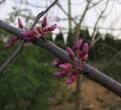Eastern Redbud Tree Information
Images of Eastern Redbud:






Eastern Redbud grows in the following 26 states and provinces:
Alabama, Arkansas, Colorado, Delaware, Florida, Georgia, Illinois, Indiana, Kansas, Kentucky, Louisiana, Maine, Michigan, Mississippi, Missouri, Nebraska, New Jersey, North Carolina, Ohio, Oklahoma, Pennsylvania, South Carolina, Tennessee, Texas, Virginia, West VirginiaInformation about Eastern Redbud:
The Cercis Canadensis is commonly known as the Eastern Redbud, Judas-tree as well as Redbud.
The currently accepted scientific name for eastern redbud is Cercis canadensis L. (Fabaceae) . Texas redbud (C. c. var. texensis Hopkins) is recognized by some authorities . Others include Mexican redbud (C. c. var. mexicana Hopkins) . Clark and Bachtell report, however, that a common opinion among nursery workers is that the two varieties represent environmentally induced morphologies (i.e. more leathery leaves in more xeric conditions) and that C. c. var. texensis and C. c. var. mexicana are all C. c. var. canadensis. Information is reported by variety in this write-up.The range of eastern redbud extends from New Jersey and Pennsylvania west to southern Michigan and southeastern Nebraska; south to eastern Texas; and east to central Florida . Its natural range appears to exclude the Gulf and Atlantic Coastal Plains . It is extinct from one locality in extreme southern Ontario . Texas redbud occurs from southern Oklahoma south to eastern, southern, and Trans-Pecos Texas; extreme southeastern New Mexico; and northern Mexico. In Mexico, its range extends from eastern Chihuahua and Coahila east to Tamps and south to San Luis Potosi and Hidalgo .Eastern redbud occurs in the open or as an understory tree common along the edge of woods in a variety of habitats . In Kentucky, it occurs on exposed limestone cliffs in eastern redcedar (Juniperus virginiana) communities . It very commonly occurs with flowering dogwood (Cornus florida) .Some of the information provided here is attributed to:Sullivan, Janet. 1994. Cercis canadensis. In: Fire Effects Information System, [Online]. U.S. Department of Agriculture, Forest Service, Rocky Mountain Research Station, Fire Sciences Laboratory (Producer). , available at the USDA Fire Effects Information System (FEIS) website